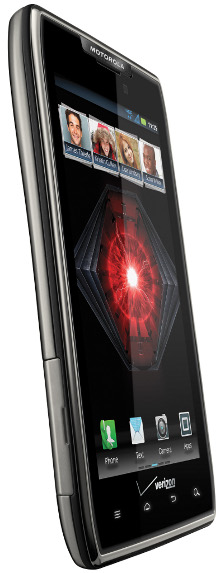Review: Razr Maxx boasts best Android smartphone battery
Jan 31, 2012 — by LinuxDevices Staff — from the LinuxDevices Archive — 8 viewsMotorola's Droid Razr Maxx is a power-packed follow-up to the company's Droid Razr handset, says this eWEEK review. Now available on Verizon Wireless, the 4.3-inch RazrMaxx zips along with a 1.2GHz, dual-core processor and 4G LTE, and positively astounds with its 3300mAh, all-day battery.
The Motorola Droid Razr Maxx was unveiled at CES earlier this month, and went on sale at Verizon Wireless last week for $300 with a two-year contract. After spending a few days with the phone, I can attest the Razr Maxx has the best battery life on an Android smartphone I've ever tested, making it the power user's best friend.
 The Android 2.3 ("Gingerbread") phone offers all of the features of its Droid Razr predecessor. That includes the 4.3-inch Super AMOLED Advanced screen with HD resolution, protected by Corning Gorilla Glass, and the phone's Kevlar fiber backbone, which together help to ward off scratches and withstand drops.
The Android 2.3 ("Gingerbread") phone offers all of the features of its Droid Razr predecessor. That includes the 4.3-inch Super AMOLED Advanced screen with HD resolution, protected by Corning Gorilla Glass, and the phone's Kevlar fiber backbone, which together help to ward off scratches and withstand drops.
Like the Razr, the Maxx is powered by a 1.2GHz dual-core CPU, 1GB of RAM, and a 4G LTE (Long Term Evolution) radio, all of which add up to .a speedy user experience. An eight-megapixel camera and other goodies are also part of the package. (For more details, see my Droid Razr review from November.)
I can confirm the call quality matches that of the Razr. So does the speed. As with the Razr, Ookla's Speedtest on the Maxx showed me anywhere from 10Mbps to 16Mbps of download speeds, and 6 to 9Mbps upload speeds.
Boffo battery
This device's battery life is roughly twice that of the original Razr. The Droid Razr has a 1780mAh battery, which was decent for a smartphone, but the Razr Maxx handset upgrades to a 3300mAh power supply.
According to Verizon, Maxx users will enjoy some 21 hours of talk time on 16.5 hours of standby time. We'll see about that, I thought.
I did two tests with this phone after going through the basic features for myself last Friday. For the first test, I powered the phone up and used it all day Saturday, making calls, sending text messages, and playing several games of Angry Birds. I downloaded two dozen apps, and watched a dozen YouTube videos of various lengths.
I even watched a movie on Netflix from the phone. (Okay, I just let the movie play — I'm not ready to spend over an hour watching something on a screen this size.)
I also played around with one of Motorola's core new applications, Smart Actions. This app let me define rules for whether the phone should silence the ringer while I'm at work, and turn it on when I'm at home. It also let me tweak the Bluetooth settings, and start playing music when headphones are plugged in.
I still had plenty of juice at the end of the day — at least a third of the total. I recharged the phone overnight and turned it on Sunday morning to begin my second test for standby battery longevity. As I wrote this, around 2PM Tuesday afternoon, Eastern Time, the Maxx was still showing three-quarters of battery life. I hadn't done a thing with it other than tap the power button to check the battery.
Here's the thing that really wowed me about this phone beyond the battery life. With a battery pack of this power, I was expecting a chunky little brick of a phone. Instead, the phone is a remarkable 8.99mm, or 0.35 inches, thick. Sure, that's thicker than the 7.1 millimeters offered by its Razr brethren, but it's about the same profile of the slim Samsung Galaxy S II handsets.
It's a marvel that Motorola packed a battery of that power into a phone this thin, and frankly - aside from the price — I'm not sure why anyone would buy another 4G LTE smartphone, such as the battery-chomping HTC Thunderbolt or Samsung Droid Charge from Verizon.
You might ask yourself whether you should buy the Razr Maxx or the Razr Maxx — both of which are scheduled for an upgrade to Android 4.0.
First, go to a local Verizon store or Best Buy and hold both in your hand. If thin and light is your top priority, the Razr is the right phone for you. If battery power sits atop your list of smartphone features, the Razr Maxx is your best bet.
Both phones cost $300, so to me buying the phone with the best power source is the obvious choice: to the Maxx, totally, and for sure.
Clint Boulton is a writer for eWEEK.
This article was originally published on LinuxDevices.com and has been donated to the open source community by QuinStreet Inc. Please visit LinuxToday.com for up-to-date news and articles about Linux and open source.